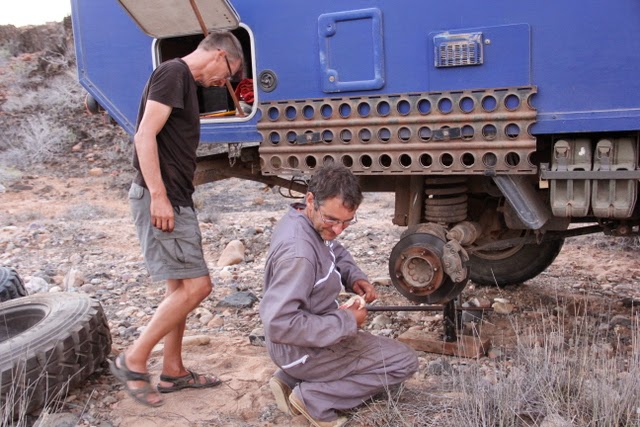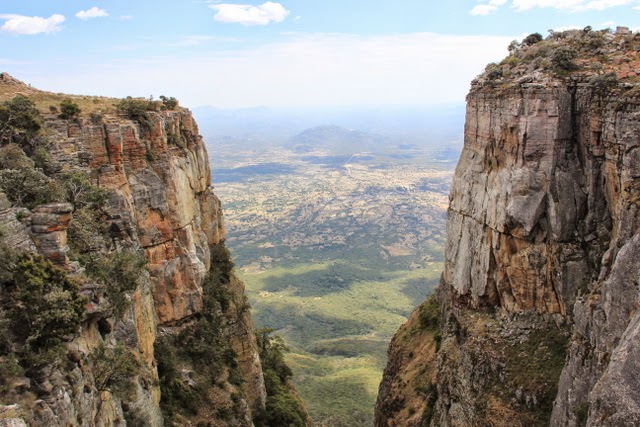The next day we thought we could take a shortcut back to the main road. We found a track that was following a dry riverbed through a beautiful canyon.
But after a couple of hours of slow driving we had to give up, it was obvious that the track had not been used for years and the bushes became too thick to continue so we had to turn around. Back at the beach, looking for a lunch spot, the unimog got stuck in the mud that was not visible under the dry sand. Fortunately after engaging the diff locks we were able to reverse out of the mud.
The next two days we drove slowly towards Namib, the biggest challenge being every night to find a nice wild camping spot on a beach. The main road was about 20km inland and there are many small tracks that cut through the hills to the beach. However these tracks are not easy to drive. In the end we did not make it to the beach either night. The first night it became dark about 3km from the beach just before a steep descent down the hill. So we decided to camp on top of the hill with a view of the ocean.
The next night was even more challenging when we again tried to follow a riverbed to the beach. The track became rockier and rockier and it was getting late. Again we decided to turn around and camp in the riverbed. However after 20 meters there was this big hiss coming from the back of the unimog and we knew immediately that this meant a flat tyre. The unimog was fortunately on a flat piece of track so it was relatively easy to change the wheel with the help of Patrick and Jeroen. The tyre was ruptured on the side which would mean in Europe and the US that you can throw the tyre away. However later in Lubango at a tyre shop they fixed the tyre and they claim that we can still use it as long as we use an inner tube.
So at the moment we have one complete spare wheel and one spare tyre with African warranty. We tried to buy a new tyre in Angola but they were more than 1100$ (more than twice the price we would pay in south Africa).
The following day we drove all the way to Lubango, taking the spectacular road from Namib that climbs into the Angolan highlands at 1900 meters.
In Lubango we stayed three days, it is a nice city and at 1700 meters it meant that it was not too hot during the day and nice and cool at night. Close to Lubango we visited Tundavala, an old volcanic plateau at 2400 meters with a spectacular view down a steep cliff to the highlands below.
From Lubango we took the main road down to Namibia. On the way there was an immigration police stop. The guy spoke English and was very friendly. He wanted to know who is paying us to be a tourist. It was very hard for him to understand that people want to visit and travel around other countries without getting paid. Tourism is still at its infancy in Angola. We asked the police man whether we could fill up our cars in Cahama, yes he said there are two filling stations there. Of course when we got there, there was only one gas station and that one did not have diesel anymore.
When will there be diesel again? we asked. Maybe this afternoon, maybe tomorrow, maybe next week they told us. Ironically, across the street 4 truck tankers with diesel from the same oil company were parked. Apparently they were on their way to the next town.
At Cahama we took a dirt track that takes you to the border crossing at Ruacana or you can take a piste all the way back to the coast to the mouth of the Kunene river. We read in an African travel magazine that this is a very spectacular route. Marc really wanted to take this route all the way but Rosana was done with bad roads, so we agreed that we would go halfway. Sonja and Jeroen were going to join us, Patrick and Martine unfortunately had to go straight to the border since the tyres on their car were too bad for this track.
In the end we did not even make it to the halfway point as both Rosana and Sonja were done with the track after two days. It was slow going, in places very bushy (the unimog broke off many low hanging branches) and in some spots the track was rough and we had to take the same way back. Marc and Jeroen would have liked to continue as the scenery was very nice and as we had some very special encounters with the local Himba people who clearly were not used to travelers. It was very special. The Himba women were very shy at first, even hiding behind the trees. They came out finally and we took their pictures, printed and gave it to them. The best part of this encounter was their reaction to the printed photos.
 |
| Baboons in the baobab tree |
 |
| Decision time: continue or turn around........the guys lost |
 |
| Himba excited about the polaroid pictures |
The border crossing at Ruacana was pretty easy. We were the only people and when we arrived someone had to call the immigration police and a custom officer. So we waited for half an hour. Jeroen and Sonja did not have an entry stamp in their carnet, so after they received the exit stamp in their passport they crossed the border into Namibia. We still had to get our carnet stamped and they also wanted to check the car on the inside. When they were done with us they wanted to see Sonja's and jeroens car, but they were already on the other side. The customs officer and a military guy were not too happy but they could not do anything.
On the Namibian side all went pretty quickly, except changing money. We still had quite some Angolan Kwanzas left and asked the custom officer if he could change money. After haggling over the exchange rate and him walking over to the Angolan side of the border to talk and negotiate with people there we finally were able to change the Kwanzas. The customs officer wanted Marc to walk with him to th Angolan side to finalize the deal but the military guy who was still upset that Jeroen and Sonja left the country without their car being inspected did not let Marc in. Marc could have shown his multiple entry visa for Angola but decided against that because they probably needed to call the immigration police again. So we gave our money to the Namibian customs officer and he was able to change the money.
After that it was one hour on a smooth and deserted tar road to the town of Ruacana were we felt like being back in civilization, a campground with individual campsites with electricity, water, braai and hot showers. In the evening we treated ourselves to a good meal and nice wine to celebrate crossing west Africa.

























No comments:
Post a Comment